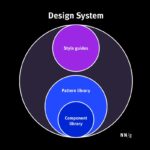A web style guide is a comprehensive document that outlines the design and content standards for a website. It serves as a blueprint for creating a consistent and user-friendly online experience, ensuring that all elements of the website work together seamlessly. Think of it as the rulebook for your website’s look, feel, and voice.
Why is a Web Style Guide Important?
Inconsistent design and content can confuse visitors, damage credibility, and make it difficult for users to find what they need. A web style guide helps to avoid these problems by providing clear guidelines on various aspects of website development, including:
- Visual Design: This encompasses elements like color palettes, typography, imagery, and logo usage.
- Content Style: Guidelines on tone of voice, grammar, spelling, and writing style ensure consistent messaging across the site.
- User Interface (UI) Elements: Standards for buttons, forms, navigation menus, and other interactive elements contribute to a unified user experience.
- Code Standards: These guidelines promote clean, efficient, and maintainable code, ensuring the website functions properly.
- Accessibility: Web style guides often include accessibility standards to ensure the website is usable by people with disabilities.
A well-defined web style guide can bring numerous benefits, including:
- Consistency: Creates a unified and professional brand image.
- Efficiency: Streamlines the design and development process, saving time and resources.
- Usability: Improves the user experience by making the website easier to navigate and understand.
- Maintainability: Simplifies website updates and maintenance.
- Scalability: Provides a framework for future growth and expansion.
Key Components of a Web Style Guide
A comprehensive web style guide should cover the following key areas:
1. Visual Design
This section focuses on the visual elements that make up the website’s look and feel.
- Color Palette: Specifies the primary, secondary, and accent colors to be used throughout the website.
- Typography: Defines the fonts, sizes, and styles for headings, body text, and other text elements.
- Imagery: Provides guidelines on the types of images to use, their size and resolution, and how they should be used in context.
- Logo Usage: Outlines the correct way to display the company logo, including size, placement, and variations.
2. Content Style
This section focuses on the writing style and tone of voice to be used on the website.
- Tone of Voice: Defines the overall tone of the website, such as formal, informal, friendly, or authoritative.
- Grammar and Spelling: Specifies the preferred grammar and spelling conventions (e.g., American vs. British English).
- Writing Style: Provides guidelines on sentence structure, paragraph length, and the use of jargon.
- Voice and Persona: Describes the brand’s personality and how it should be reflected in the website’s content.
3. User Interface (UI) Elements
This section defines the standards for interactive elements on the website.
- Buttons: Specifies the appearance and behavior of buttons, including color, size, and text.
- Forms: Provides guidelines on form design, including input fields, labels, and validation messages.
- Navigation: Defines the structure and appearance of navigation menus and other navigational elements.
- Icons: Specifies the style and usage of icons throughout the website.
4. Code Standards
This section focuses on the technical aspects of website development.
- HTML: Specifies the preferred HTML structure and coding conventions.
- CSS: Defines the CSS rules and guidelines for styling the website.
- JavaScript: Provides guidelines on the use of JavaScript for adding interactivity and functionality.
- Accessibility: Outlines the accessibility standards to be followed, such as WCAG guidelines.
5. Accessibility
Ensuring your web content is accessible is vital to inclusivity. It covers a variety of disabilities, including:
- Visual
- Auditory
- Physical
- Speech
- Cognitive
- Neurological
Web accessibility not only helps those with disabilities, but also can improve search engine optimization.
Creating Your Web Style Guide
Creating a web style guide is an ongoing process that should involve input from designers, developers, content creators, and other stakeholders. Here are some tips for creating an effective web style guide:
- Start with a Plan: Define the scope and goals of the style guide.
- Gather Input: Collect feedback from all stakeholders to ensure the style guide meets their needs.
- Be Specific: Provide clear and detailed guidelines, leaving no room for ambiguity.
- Use Examples: Illustrate your guidelines with real-world examples.
- Keep it Updated: Regularly review and update the style guide to reflect changes in technology and design trends.
Conclusion
A web style guide is an essential tool for creating consistent, user-friendly, and maintainable websites. By defining clear standards for design, content, and code, a web style guide ensures that all elements of the website work together seamlessly to provide a positive user experience. It will improve your website and overall branding.
